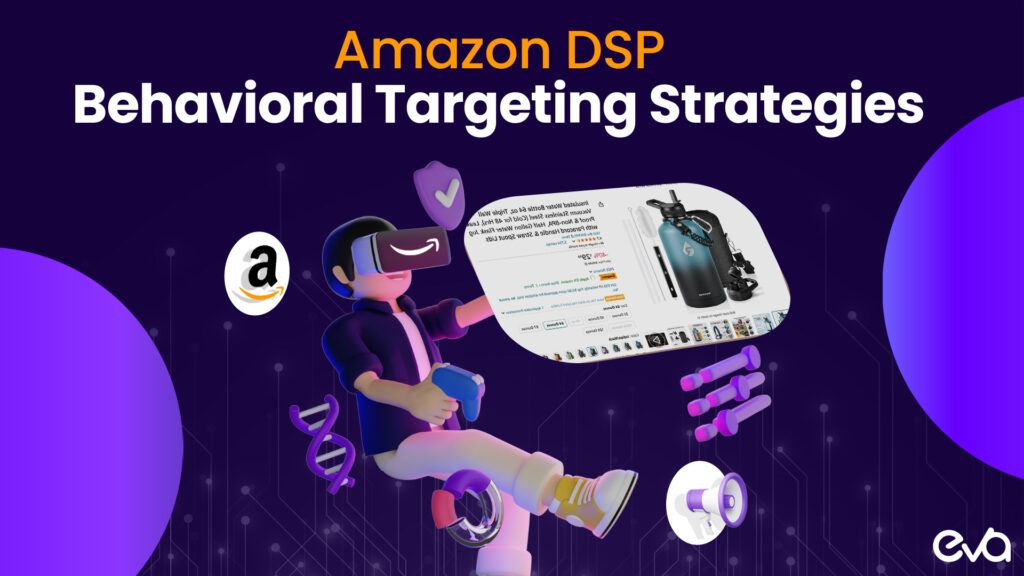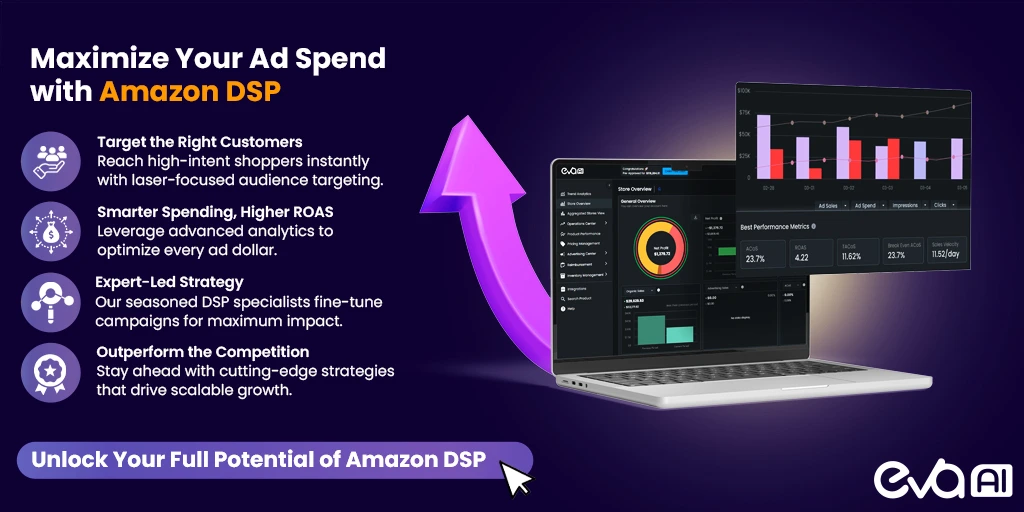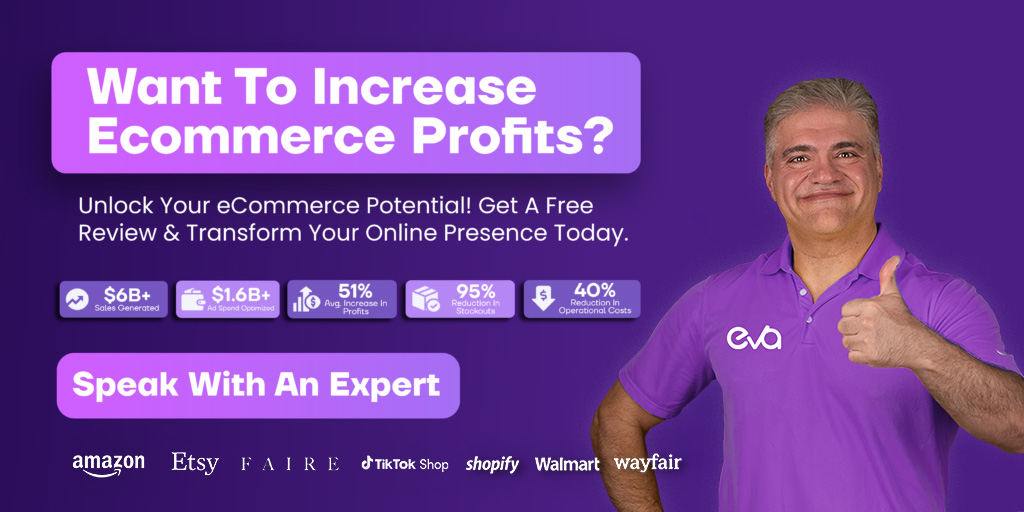Amazon DSP, or Demand-Side Platform, is a powerful advertising platform that allows advertisers to purchase display, video, and audio ads on a large scale.
With access to Amazon’s extensive customer data, advertisers can reach targeted audiences both on and off Amazon.
This platform plays a pivotal role in digital advertising by offering a way to tap into Amazon’s first-party data, helping brands increase their visibility and boost conversions across various channels.
Why Amazon DSP Matters in Digital Advertising
In the fast-paced world of digital advertising, reaching the right audience at the right moment is crucial.
Amazon DSP stands out because it not only provides access to Amazon’s data but also offers broad reach across online platforms, including third-party websites and apps.
For brands aiming to enhance their visibility and drive more conversions, Amazon DSP offers a valuable tool.
Behavioral targeting within Amazon DSP further refines this approach by allowing advertisers to focus on users based on their past behaviors—such as products viewed, content engaged with, and previous purchases.
This targeted approach increases the likelihood of conversion by ensuring ads reach users who have already shown interest in similar products or services.
Table of Contents
What Is Behavioral Targeting in Advertising?
Behavioral targeting in advertising involves delivering ads to users based on their previous online activities.
This includes actions like pages visited, products viewed, content consumed, and search queries.
By analyzing these behaviors, advertisers can create ads that are more relevant and personalized, which resonates with the users’ interests and needs.
This approach is crucial in modern advertising because it shifts the focus from broad, generic ads to ones that are highly personalized.
By doing so, the relevance of ads increases, enhancing the user experience by presenting content that aligns with their preferences and behaviors.
The Benefits of Behavioral Targeting
Behavioral targeting offers several advantages that make it a vital part of any digital advertising strategy:
- Relevance and Engagement: Targeting users based on their behavior ensures that ads are more relevant, leading to higher engagement rates.
- Improved User Experience: Personalized ads enhance the user experience by presenting content that aligns with their interests, reducing ad fatigue.
- Better Resource Allocation: By directing ad spend towards the most promising audience segments, behavioral targeting helps maximize ROI.
- Increased Conversion Rates: Ads tailored to the user’s past behavior are more likely to result in conversions, whether that’s a purchase, a sign-up, or another desired action.
- Compliance with Privacy Regulations: When implemented correctly, behavioral targeting can comply with data privacy regulations by using anonymized data and respecting user preferences.
- Informed Decision-Making: Behavioral targeting provides insights into consumer behavior, helping advertisers make informed decisions and optimize their campaigns continuously.
Core Metrics in Behavioral Targeting
Behavioral targeting relies on various data points to deliver ads that resonate with users:
- Pages Visited: Helps identify user interests through the pages they visit, allowing ads to be tailored accordingly.
- Clicks and Interactions: Monitoring which links, buttons, and content users engage with provides insights into what captures their attention.
- Products Added to Cart: Tracking items added to a cart or wish list indicates strong purchase intent, making users ideal candidates for targeted ads.
- Time Spent on Pages: The duration a user spends on a page can suggest their level of interest, which can be leveraged to prioritize certain ads.
- Search Queries: Search history and other interactions offer a wealth of information about a user’s needs and interests, making them ideal for behavioral targeting.
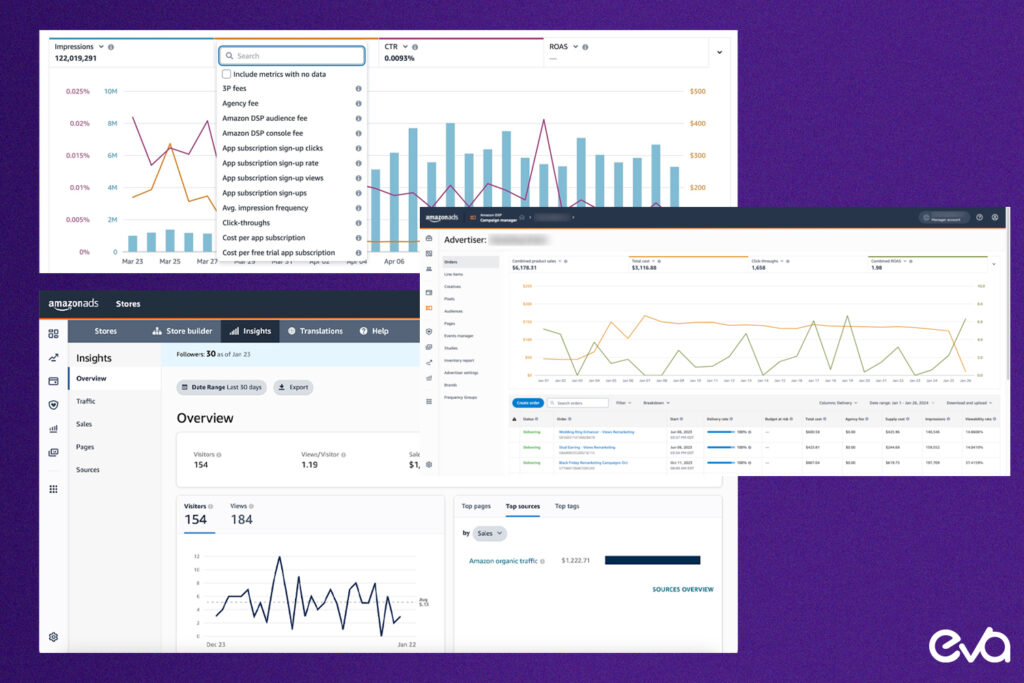
Types of Behavioral Targeting
Onsite Behavioral Targeting
Onsite behavioral targeting involves delivering personalized ads and content to users based on their interactions within a specific website.
This method is particularly effective for e-commerce platforms, where understanding a user’s journey through the site can inform which products or services are advertised.
Examples of Onsite Behavioral Targeting:
- Product Recommendations: Displaying related products based on the items a user has viewed or purchased.
- Dynamic Content: Changing website banners or featured products based on the user’s browsing history.
- Cart Abandonment Reminders: Personalized messages or ads reminding users of items left in their shopping cart.
Network Behavioral Targeting
Network behavioral targeting extends the concept of behavioral targeting across multiple websites.
This approach allows advertisers to follow users beyond a single website and deliver consistent, relevant ads as they browse different sites within the network.
Examples of Network Behavioral Targeting:
- Retargeting Ads: Following users who have shown interest in specific products with targeted ads across various sites.
- Cross-Device Targeting: Ensuring that ads are consistent across all devices a user might use, such as mobile phones, tablets, and desktops.
Key Behavioral Targeting Signals
Key behavioral targeting signals, such as user interactions, browsing patterns, and purchase history, provide crucial insights into user behavior and preferences.
These signals enable advertisers to create targeted ads that align closely with users’ interests, to make sure higher relevance and effectiveness in driving engagement and conversions.
These signals are critical in crafting targeted ads that resonate with users’ interests:
- Website Engagement: Actions like clicks, scrolls, and interactions with specific elements on the website indicate interest.
- Campaign Participation: Data from users who participate in promotions, surveys, or contests can be used to target them with similar offers or related content.
- Buying Patterns: Purchase history and buying behavior are strong indicators of future purchasing intent.
- App Interaction: Tracking user interactions within a mobile app can inform ad targeting both within the app and across other digital channels.
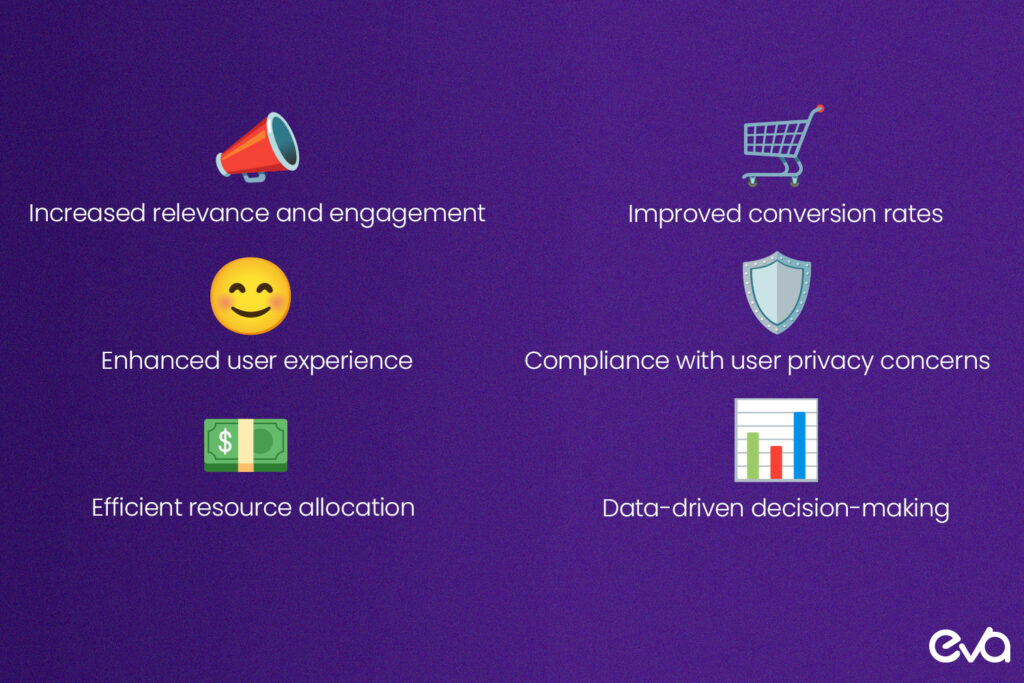
How Behavioral Targeting Works on Amazon DSP
The Process of Behavioral Targeting
Behavioral targeting on Amazon DSP involves analyzing user behavior to deliver highly personalized ads. The process begins with data collection, where user interactions are recorded and analyzed.
This data is then used to create user profiles, which segment audiences based on their behaviors.
These profiles guide the targeting and delivery of ads, ensuring that the most relevant ads reach the right users at the right time.
Steps in Behavioral Targeting
Behavioral targeting on Amazon DSP involves three essential steps and they are collecting and analyzing user data, segmenting audiences based on behavior, and applying these insights to deliver personalized ads.
Each step is crucial for ensuring that the ads are relevant and effectively reach the intended audience, ultimately driving better engagement and conversion rates.can be broken down into three key steps:
- Data Collection: Amazon DSP gathers comprehensive user data, essential for effective targeting.
- User Profiling or Segmentation: Creating detailed profiles that categorize users based on specific behaviors.
- Ad Targeting and Delivery: Ads are served based on the user’s past behavior, making them more relevant and effective.
- Ad Personalization and Optimization: Regular monitoring and optimization ensure that ads remain engaging and effective throughout the campaign.
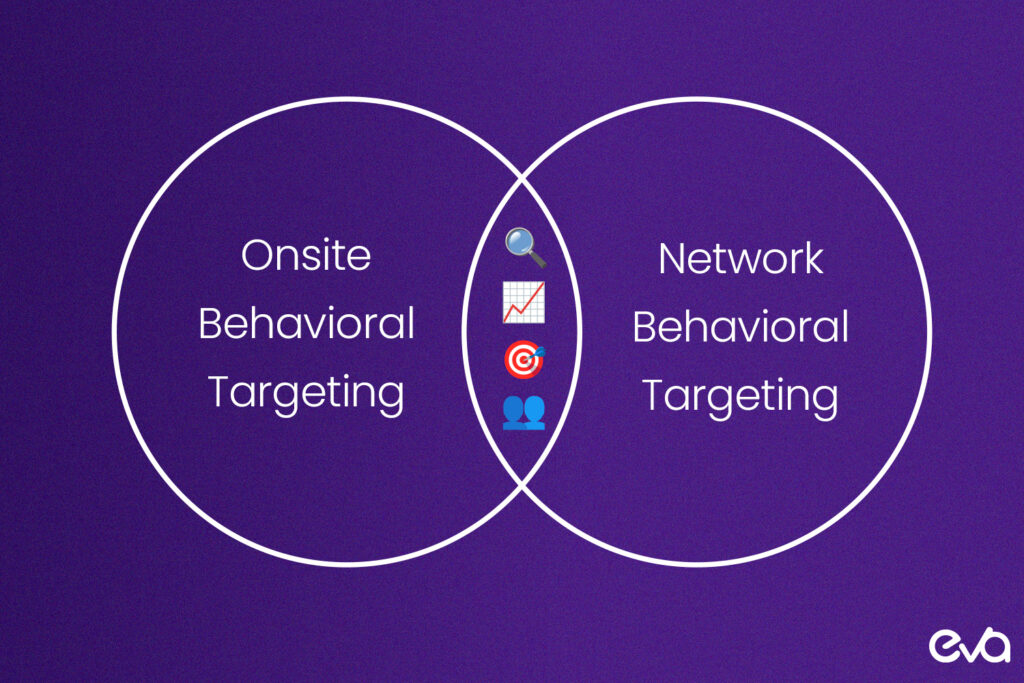
Key Strategies for Effective Behavioral Targeting on Amazon DSP
Audience Segmentation
Audience segmentation is a vital strategy in behavioral targeting, as it allows advertisers to break down a large, diverse audience into smaller, more targeted groups.
These segments are created based on common traits, behaviors, and preferences, enabling marketers to tailor their messaging and ads more effectively.
How to Segment Audiences:
- Behavioral Data: Use past purchase history, browsing patterns, and interactions with specific products to create detailed audience segments.
- Demographic Information: Leverage data like age, gender, location, and income level to refine your segments.
- Psychographic Data: Incorporate information on interests, values, and lifestyle choices.
Best Practices:
- Regular Updates: Audience preferences can change, so keep your segments updated.
- Lookalike Audiences: Amazon DSP allows for creating lookalike audiences based on top-performing segments.
Personalizing Ads with Behavioral Data
Personalizing ads with behavioral data allows advertisers to tailor messages that align with users’ specific interests and needs.
By analyzing browsing history, purchase patterns, and content interactions, ads become more relevant, boosting engagement and conversion rates.
This targeted approach strengthens the connection between brands and consumers, driving better campaign results.
Techniques for Using Behavioral Data:
- Dynamic Content: Adjust content in real-time based on user behavior.
- Product Recommendations: Recommend products the user has shown interest in.
- Customized Messaging: Modify messaging to reflect the user’s past interactions.
Leveraging Amazon’s First-Party Data
Leveraging Amazon’s first-party data allows advertisers to create highly targeted campaigns based on user behavior, such as purchase history and search queries.
This data enhances audience segmentation, improves ad relevance, and drives higher engagement and conversion rates, making it a key asset for optimizing campaigns on Amazon DSP.
Strategies for Combining Data:
- Enhance Precision: Combine Amazon’s data with third-party sources for more refined audience segments.
- Expand Reach: Create lookalike audiences that resemble your highest-value customers.
- Real-Time Optimization: Continuously monitor and adjust campaigns based on real-time data.
Real-Time Bidding and Behavioral Targeting
Real-time bidding (RTB) is a key part of Amazon DSP, allowing advertisers to bid for ad placements in real-time.
How Behavioral Data Influences Bids:
- Value-Based Bidding: Adjust bids based on the likelihood of conversion.
- Dynamic Adjustment: RTB enables bids to be adjusted as new data comes in.
Tips for Optimizing Bids:
- Clear Objectives: Define what you want to achieve with your RTB strategy.
- Monitor Performance: Regularly review bids and adjust as needed.
Integrating Behavioral Targeting with Other Strategies
Combining behavioral targeting with other strategies can create a more comprehensive advertising campaign.
How to Combine Strategies:
- Contextual Targeting: Serve ads based on the content a user is currently viewing.
- Demographic Targeting: Use demographic data to refine your audience segments further.
- Geographic Targeting: Target users based on their location.
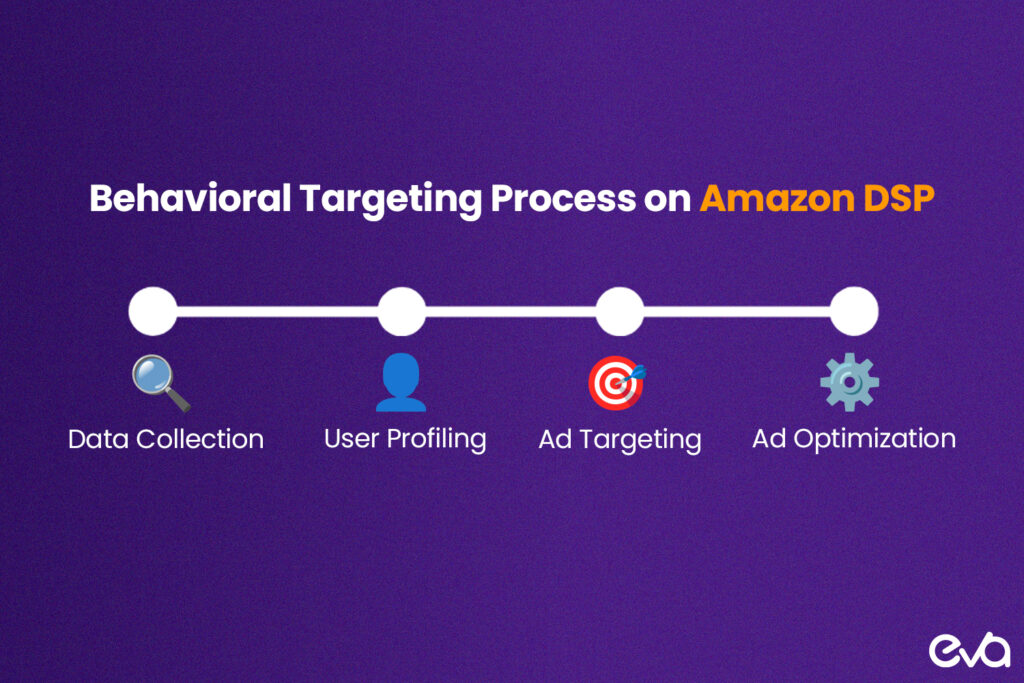
Practical Applications of Amazon DSP Behavioral Targeting
Behavioral Targeting for E-commerce Businesses
Behavioral targeting offers significant advantages for e-commerce businesses by enabling them to deliver highly relevant ads to users based on their online behavior.
How E-commerce Businesses Can Leverage Amazon DSP’s Behavioral Targeting:
- Targeting High-Intent Shoppers: Use Amazon DSP to identify users who have shown purchase intent.
- Cross-Selling and Upselling: Leverage behavioral data to suggest additional products.
- Retargeting Cart Abandoners: Send reminders to users who have left items in their shopping carts.
Measuring ROI for E-commerce Campaigns:
- Conversion Tracking: Monitor how many users made a purchase after seeing an ad.
- Customer Lifetime Value: Consider the long-term value of customers acquired through behavioral targeting.
- A/B Testing: Test different ad creatives to find the most effective approach.
Behavioral Targeting in Various Industries
While behavioral targeting is powerful in e-commerce, its applications extend far beyond retail.
Industries That Benefit Most from Behavioral Targeting:
- Healthcare: Delivering ads for health-related products based on users’ search history.
- Finance: Promoting financial products like credit cards or loans to users who have shown interest in financial planning.
- Travel and Hospitality: Targeting users with personalized travel offers based on their past searches and bookings.
Examples of Successful Campaigns:
- Retail: A fashion brand used behavioral targeting to retarget users who had browsed but not purchased items, increasing sales.
- Healthcare: A pharmaceutical company targeted users searching for allergy treatments, leading to higher ad engagement.
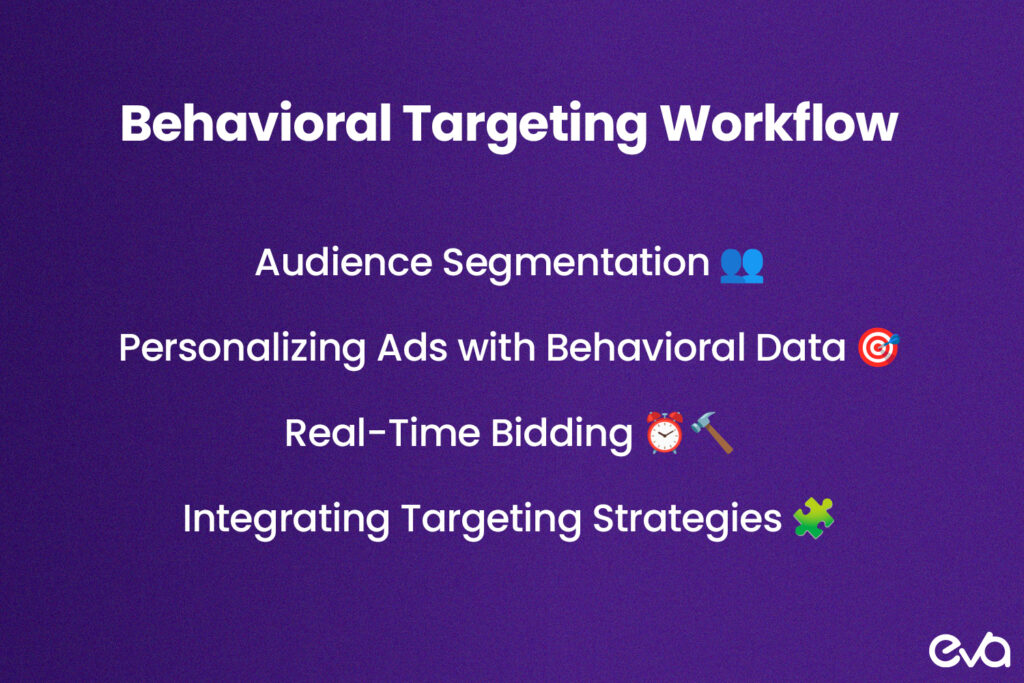
How Can Eva Improve Amazon DSP Behavioral Targeting
Eva Guru is an AI-powered tool that seamlessly integrates with Amazon DSP, leveraging advanced technology and Amazon’s data infrastructure to help advertisers achieve superior results.
By offering precise data analysis, real-time optimization, and detailed analytics, Eva Guru enhances behavioral targeting on Amazon DSP.
It enables more accurate targeting, delivers personalized ad experiences, and provides enhanced campaign monitoring, ensuring that advertisers can optimize their strategies effortlessly for better performance and higher ROI.
How Eva Guru Enhances Targeting:
- Data Analysis and Segmentation: Eva Guru helps identify patterns in user behavior, leading to more refined audience segments.
- Real-Time Optimization: Eva Guru’s AI algorithms continuously monitor performance, making real-time adjustments to maximize conversions.
- Personalized Ads at Scale: Eva Guru automates the personalization process, ensuring that ads remain relevant even as campaigns scale.
- Campaign Monitoring: Eva Guru provides detailed insights into campaign performance, allowing advertisers to refine their strategies continuously.
Getting Started with Eva Guru for Amazon DSP Behavioral Targeting
- Setup: Start by setting up your Eva Guru account and linking it to your Amazon DSP campaigns.
- Launch: Begin your first campaign with Eva Guru, which will analyze your audience data and optimize ad placements.
- Monitor: Use Eva Guru’s dashboard to monitor performance in real-time and implement recommendations.
- Refine: After the campaign ends, review the insights and refine your strategies for future success.
Conclusion
Behavioral targeting on Amazon DSP is more than just a tool—it’s a strategy that can transform your advertising efforts.
By focusing on user behavior, you can create highly relevant and personalized ads that resonate with your target audience, driving higher engagement and boosting ROI.
As digital advertising continues to evolve, leveraging these advanced targeting techniques is essential for staying ahead of the competition and maximizing the impact of your campaigns.
Ready to take your Amazon DSP campaigns to the next level? Book a meeting now!
FAQs
Amazon DSP is a programmatic advertising platform that allows advertisers to buy display, video, and audio ads at scale. It offers access to Amazon’s first-party data, enabling targeted ads both on and off Amazon’s properties.
Behavioral targeting on Amazon DSP involves analyzing user behavior to deliver personalized ads. This process includes data collection, audience segmentation, and ad delivery through real-time bidding and optimization.
Behavioral targeting on Amazon DSP is effective for reaching and engaging your target audience, leading to higher conversion rates and ROI.
Industries like retail, healthcare, finance, and travel benefit significantly from behavioral targeting on Amazon DSP, as it allows for highly personalized ad delivery.
Track metrics like conversion rate, click-through rate, return on ad spend, and customer engagement to measure the success of your behavioral targeting campaign.
Behavioral targeting challenges are data privacy concerns, ad fatigue, and the complexity of integrating data from multiple sources. Eva Guru can help you overcome these obstacles by ensuring privacy compliance, optimizing ad frequency, and streamlining data integration, allowing advertisers to maximize the effectiveness of their campaigns while maintaining user trust.

